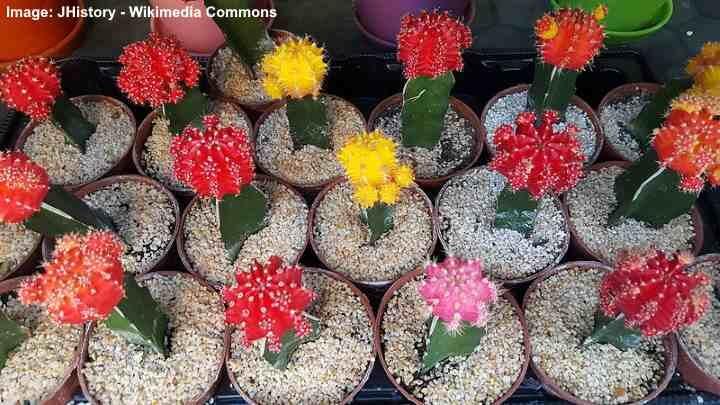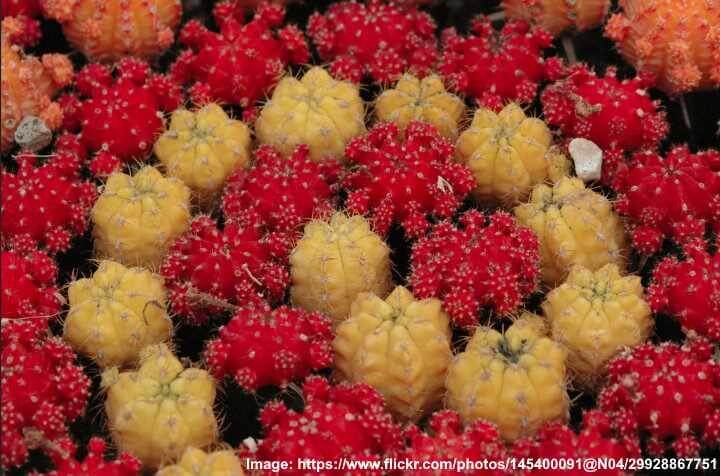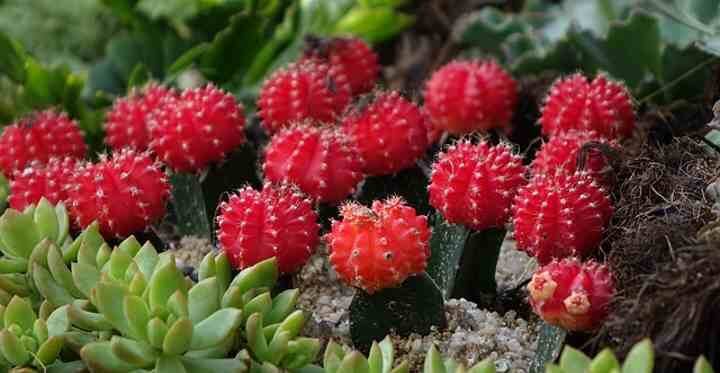Moon Cactus or Ruby Ball Cactus is a cactus species from South America. The scientific name of Moon Cactus is “Gymnocalycium mihanovichii”.
It belongs to the kingdom of Planate. In general, the moon and cactus have different sizes and heights.
But they stop growing further once they reach 10cm in height. The average height of this cactus is around 4 inches, and a diameter of 1.1 to 1.9 inches.
It has around 10-14 slightly notched ribs with narrow knives. It is available in colors like yellow, green, red, etc.
Moon cactus is a kind of grafted cactus with a colorful small-ball top. It is also known as the ruby-ball, Hibotan, or Star-flowered cactus.
This cactus is very easy to grow and maintain in our homes. Moon cactus combines two different cacti that have been grafted together.
Some of these colorful cactus plants have multi-colored or variegated tops—but all have clusters of small, sharp spines running down the curved veins.
Before getting into the details of the steps to grow and protect a grafted cactus, one needs to know its origin.
Origin of Grafted Cactus

The small cactus plants of different colors available in the market or shops are not as vivid as wild cactus plants.
Cactus plants with pink, bright red, orange, and yellow are natural cacti.
They are found in between Paraguay and Argentina. But cactus with neon colours cannot produce chlorophyll, which is necessary for a plant to live.
To save such a cactus, the round grafted cactus is transformed into a regular grafted cactus. Any color can be used to create the moon cactus.
In general, the species used is Hylocereus for sale in the garden.
Green coloured have a star-shaped on their stems because of which moon cactus is also named as Star-flowered cactus.
Any cactus will survive till proper care is taken. The moment you neglect to take care of the cactus, it dies.
Factors to Consider while Growing Ruby Ball Cactus

Growing any plant soil is crucial for healthy growth. Soil differs from plant to plant per climatic conditions, temperature, and place.
It is advisable to choose the right soil before you start growing the grafted cactus. For a moon cactus, the best soil is aerated and sandy.
This allows absorbing water in good proportions. Adding small stones or pebbles to the potting mix used to grow the cactus can improve the soil quality.
For every plant, some succulents are used in soil to make it best for its growth. In a similar manner, moon-grafted cacti prefer a potting mix that is acidic to neutral.
These are slow-growing. On average, it grows between 1-3 cm per year. Moon cacti are sold only when they are fully grown, which is a time-consuming process.
1. Light
It is essential to decide the correct amount of light required for moon cactus (grafted cactus) to grow properly.
This is one of the main factors that can improve or destroy growth.
This moon cactus requires plenty of light for its growth. Direct sunlight is not advisable as it can affect growth.
To grow at your home, prefer the brightest side of the home, either a windowsill or your balcony shelf.
Both have protection from direct sunlight, yet they are on the brightest side and in the perfect place.
Grafted cactus has a shade tolerance on its top, which does not support direct sunlight.
Ensure there is the right balance of light for the moon cactus. By overexposure to the sun, the cactus may turn yellow and some parts of the cactus white.
It is better to move the grafted cactus away from the sun.
2. Water
Water is the heart and soul of any plant. A perfect proportion of water is required for the moon cactus at regular intervals.
Never overwater the cactus, as this can affect the growth of the grafted cactus. Soil must remain moist, which is done by regularly watering.
Without water, there is no growth of this. Moon cactus or grafted cactus are drought tolerant.
The Deep-watering technique is used for watering the pots.
Watering your cactus plant when the pot is almost dry is advisable. The proportion of water depends on temperature and humidity.
Watering is done once a week during summer for small, grafted cactus. During cool climatic conditions, the watering routine is different.
Keep the pot dry during winter. Occasionally, misting your cactus houseplants helps to keep them healthy.
3. Temperature
Moon or colorful grafted cactus prefers warm or ideal room temperatures for healthy growth.
Different prefer different temperatures because of their color origin. Moon cactus thrives better by placing it on a window as sufficient heat is provided.
At the same time, protect them from direct sunlight. Starflower cactus prefers temperatures between 64 to 77 degrees Fahrenheit for their growth.
If you opt to grow the moon cactus outdoors, it is perfect if you belong to USDA zone 10 or 11. Extra care must be taken if you grow outdoors as temperature varies from season to season.
A shady place with a bright light in your backyard is best for their growth. During rain or any natural calamity, take cactus indoors to safeguard them.
Note: A colorful grafted cactus or a moon cactus cannot survive if the temperature is below 48 degrees Fahrenheit.
4. Humidity
This factor helps in cactus growth. Colored grafted cactus is easygoing when it comes to moisture needs.
Moisture keeps the soil damp, which is essential for the cactus plants. Small household moon cacti or grafted cacti prefer relatively humid conditions for their growth.
It can even grow in low, humid conditions. An important tip regarding this factor is ensuring the soil is dry before adding moisture.
If it is damp already, the soil gets too moist, which is not a good sign for graft growth. Cactus with yellow, red, or pink colored tips require misting to keep them healthy.
Misting provides enough moisture without making the soil damp.
Note: Watering the moon cactus is prohibited from October to February.
5. Food
Providing healthy food to cacti is the essential tip while growing a moon cactus or colored grafted.
There is no need to feed a ruby ball cactus very often.
It is very good to use the soil with a good mix of nutrients and minerals that can make the cacti healthy.
Monthly fertilizing keeps them healthy. Never use inorganic fertilizers for feeding.
Using an organic-based cactus fertilizer for feeding the moon cactus is always good. Read the instructions mentioned on the label and mix it with the manufacturers.
Top moon cactus care tip—flush the soil before monthly feeding. To do this, thoroughly water your cactus plant.
Use enough water that is about four times the pot’s volume. Allow the water to drain completely before adding the cactus fertilizer.
Always follow a routine for feeding the fertilizers from overdose usage of fertilizers. An overdose of fertilizers can damage the cactus growth.
Note: Never feed your moon cactus during the fall or winter seasons. It affects their growth.
6. Potting
There is a certain way designed to pot a moon cactus. Repotting is very rare for moon cactus or ruby ball cactus.
Ensure that the pot size is slightly bigger than the normal one. This hard grows well when they are slightly rootbound.
The best time to repot your moon cactus is spring and early summer.
Steps to re-pot the moon cactus:
- Before you report the cactus, plan a week to water the soil thoroughly.
- Wait till the soil becomes completely dry to remove the cactus from the pot. Remove the cactus slowly from the pot by pulling the green stock so the colored top is not disturbed.
- Once the cactus is removed from the soil, check whether there are any diseased or dead roots left inside the soil.
- Once you find such kinds of roots, remove them from the pot smoothly.
- Fill a new pot with good quality organic cactus mix till half of the pot is full.
- After filling the pot, place the cactus at the exact position and height of the previous pot.
- Fill the pot with potting mix and gently press the soil around the rootstock.
- After the entire procedure, place the pot in a bright position away from the direct sunlight.
For safety measures, do not water the cactus for seven days after potting it. The pot’s new soil increases a moon cactus’s life span.
Caring for Ruby Ball Cactus

When growing a moon cactus, water, light, and humidity are common problems. Too much water affects the cacti, and less water affects them.
A moon cactus changing to yellow color is because of a water issue. Too much sunlight also affects the ruby ball cacti as it turns yellow. One can observe white scars on the stem.
Inorganic fertilizer can stop the growth of the moon cactus.
To ensure your Moon Cactus (Gymnocalycium mihanovichii) thrives, understanding the right watering practices is crucial.
This cactus, like many succulents, prefers a balance in moisture levels — not too wet, not too dry.
Here are actionable tips to help you identify when your Moon Cactus needs water and how to avoid common watering pitfalls such as under-watering and over-watering.
1. Signs of Under-Watering
- Shriveled or Wrinkled Pads: If the cactus pads begin to look shriveled or wrinkled, it’s a clear sign that the plant is dehydrated. The cactus uses the water stored in its pads, and when this reserve is low, the pads start to shrink.
- Dull, Flat Color: A healthy Moon Cactus has a vibrant color. If the cactus loses its luster and appears duller than usual, it might need a drink.
- Slow Growth or No Growth: While Moon Cacti are slow growers, a prolonged period without growth might indicate a lack of water.
- Dry Soil: If the top 1-2 inches of soil feel completely dry, it’s time to water your cactus. Always check the soil moisture level before watering to ensure it’s necessary.
2. Signs of Over-Watering
- Soft, Mushy Pads: Over-watering can lead to rot, making the cactus pads feel soft and mushy. This is often accompanied by discoloration.
- Yellowing or Brown Spots: If you notice yellow or brown spots on the cactus, this could signify root rot caused by excessive moisture.
- Soil Never Dries Out: Cactus soil should dry out between waterings. If the soil remains consistently wet, it’s a sign of over-watering.
- Foul Smell from Soil: An unpleasant, musty smell from the pot indicates that the roots may rot due to too much water.
3. Watering Tips for Moon Cactus
- Check Soil Moisture: Before watering, always check the soil’s moisture. Stick your finger about an inch into the soil; it’s time to water if it feels dry.
- Deep Watering Method: When you do water, ensure it’s thorough. Water deeply until excess water drains out of the bottom of the pot, ensuring the roots receive sufficient moisture. Allow the soil to dry out completely before the next watering.
- Seasonal Adjustments: Moon Cacti need less water in the cooler months and slightly more during the growing season (spring and summer). Reduce watering frequency in the winter to prevent over-watering.
- Use the Right Pot and Soil: Ensure your Moon Cactus is in a pot with drainage holes, and use a well-draining cactus or succulent soil mix to prevent water from pooling around the roots.
By observing your Moon Cactus closely and responding to its needs, you can maintain the perfect moisture balance to keep your plant healthy and vibrant.
Remember, it’s usually safer to under-water than over-watering a cactus when in doubt.
Moon cactus a kind of grafted cactus cannot be propagated. To increase the life span of a moon cactus, you need to know how to graft the cactus.
Learn grafting skills to increase their life span. You can also graft a healthy G. Milanovich with a healthy Holocene to create your unique type of cactus.
Growing a moon cactus is not easy if you follow the abovementioned steps. If you still have any doubts, seek professional help to grow and take care of a moon cactus.
Final Words
In conclusion, mastering the art of watering is pivotal for the health and vitality of your Moon Cactus.
You can ensure your cactus thrives by recognizing the signs of under-watering and over-watering, such as shriveled pads or mushy textures, and adhering to best practices like the deep watering method and seasonal adjustments.
Remember, the key lies in maintaining a balance—providing enough moisture to support growth while avoiding excess that can lead to root rot.
Utilizing well-draining soil and pots with adequate drainage further safeguards against over-watering risks.
Observing your Moon Cactus’s responses to watering and adjusting your care routine will help you foster a resilient and vibrant plant.
Embrace these guidelines as a foundation for nurturing your Moon Cactus, and enjoy watching this unique and colorful succulent flourish in your care.

